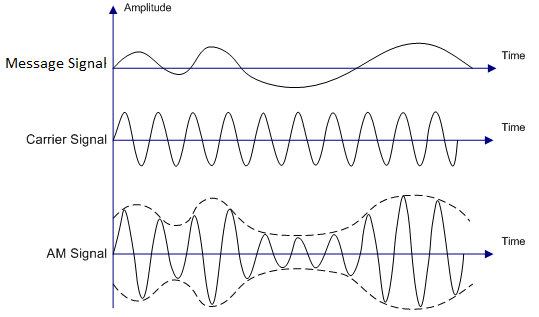
Amplitude modulation is used for broadcasting because:
A. It is more noise immune
B. It requires less transmitting power
C. It has simple circuitry
D. It has high fidelity (faithful reproduction)
Answer
512.7k+ views
Hint: The ease of decoding the message at the receiver’s end plays a big part in deciding which type of modulation is to be used for broadcasting. Since broadcasting is done to a large mass of receivers, it is necessary that the simplest technology and machinery is implemented which is easily available to the masses.
Complete answer:
Amplitude modulation is a process in which a message (modulated) signal is transmitted via a channel by enveloping it with a carrier signal of much greater frequency. In this way the carrier signal carries the main message signal along with it and does not allow it to be lost due to energy dissipation by the medium in which it travels.
The below graph of the message signal, carrier signal and modulated signal plotted against time will make the concept clearer.

Amplitude modulation has been used for many decades especially in radio broadcasting. One of the most important factors which promoted the use of amplitude modulation in radio broadcasting is the simple machinery and circuitry required at the receiver’s end. A simple diode circuit is enough at the receiver’s end to properly receive the modulated signal and get the original message.
Since, while broadcasting, there are a large number of receivers which are the common masses of public, it is essential that the machinery and circuitry involved be simple and compact so that everyone can accommodate and use it properly.
Amplitude modulation serves this purpose perfectly as explained above and hence is used for broadcasting.
So, the correct answer is “Option C”.
Note:
Students might think that why is modulation even necessary? Without it, won’t the process become even simpler, since there will be no need for decoding the message at the receiver’s end. However, this is not true since the message signal is usually of a low frequency (and high wavelength) which suffers greater attenuation (dissipation of energy by the medium). Enveloping it with a carrier wave of higher frequency, the attenuation is small (since the wavelength of the carrier wave is small) and hence, the message signal also travels without much attenuation and is received completely on the receiver’s end.
Complete answer:
Amplitude modulation is a process in which a message (modulated) signal is transmitted via a channel by enveloping it with a carrier signal of much greater frequency. In this way the carrier signal carries the main message signal along with it and does not allow it to be lost due to energy dissipation by the medium in which it travels.
The below graph of the message signal, carrier signal and modulated signal plotted against time will make the concept clearer.

Amplitude modulation has been used for many decades especially in radio broadcasting. One of the most important factors which promoted the use of amplitude modulation in radio broadcasting is the simple machinery and circuitry required at the receiver’s end. A simple diode circuit is enough at the receiver’s end to properly receive the modulated signal and get the original message.
Since, while broadcasting, there are a large number of receivers which are the common masses of public, it is essential that the machinery and circuitry involved be simple and compact so that everyone can accommodate and use it properly.
Amplitude modulation serves this purpose perfectly as explained above and hence is used for broadcasting.
So, the correct answer is “Option C”.
Note:
Students might think that why is modulation even necessary? Without it, won’t the process become even simpler, since there will be no need for decoding the message at the receiver’s end. However, this is not true since the message signal is usually of a low frequency (and high wavelength) which suffers greater attenuation (dissipation of energy by the medium). Enveloping it with a carrier wave of higher frequency, the attenuation is small (since the wavelength of the carrier wave is small) and hence, the message signal also travels without much attenuation and is received completely on the receiver’s end.
Recently Updated Pages
Master Class 12 Economics: Engaging Questions & Answers for Success

Master Class 12 Maths: Engaging Questions & Answers for Success

Master Class 12 Biology: Engaging Questions & Answers for Success

Master Class 12 Physics: Engaging Questions & Answers for Success

Basicity of sulphurous acid and sulphuric acid are

Master Class 12 Business Studies: Engaging Questions & Answers for Success

Trending doubts
What are the major means of transport Explain each class 12 social science CBSE

Which are the Top 10 Largest Countries of the World?

Draw a labelled sketch of the human eye class 12 physics CBSE

How much time does it take to bleed after eating p class 12 biology CBSE

Explain sex determination in humans with line diag class 12 biology CBSE

Differentiate between homogeneous and heterogeneous class 12 chemistry CBSE




